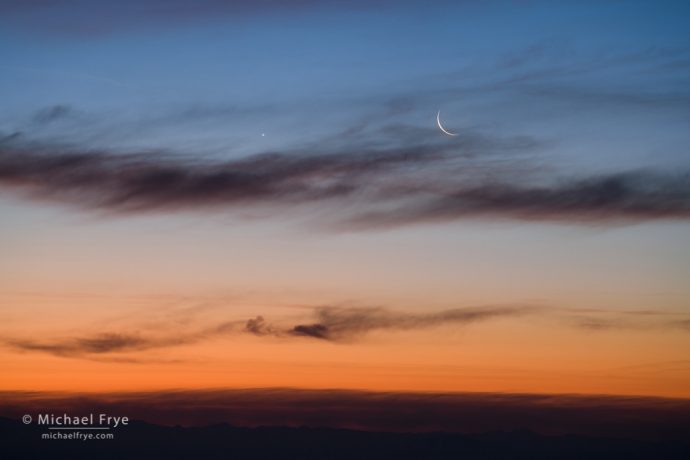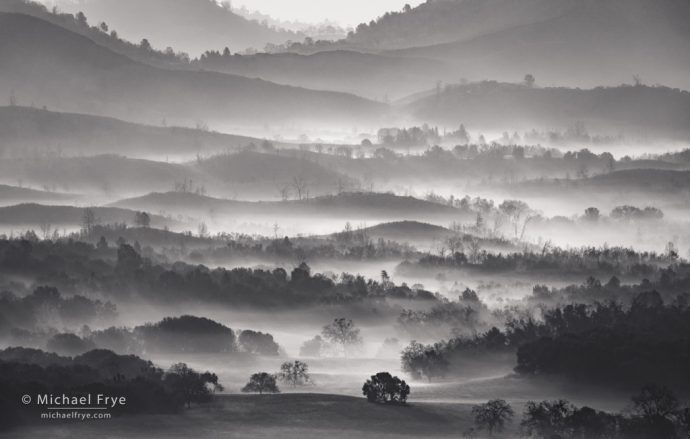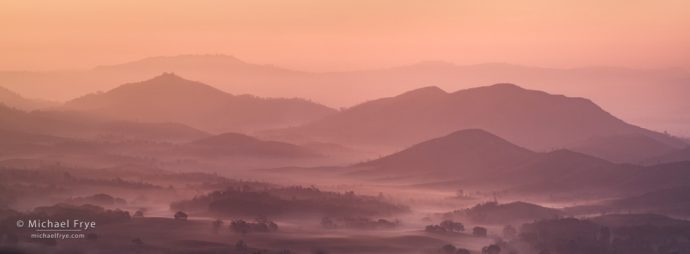A few days ago I checked to see if fog might be pushing up into the Sierra foothills again. It’s often hard to get a good picture of what’s happening with the weather in the predawn darkness, but things looked promising enough to make me grab my gear and drive out to one of the local viewpoints.
When I arrived it was light enough to see that there wasn’t a distinct band of fog below. Instead, I found diffused layers of mist. That wasn’t what I was looking for, so for a second I considered turning around and heading home. But I was already up, and out, and then I spotted Venus and the crescent moon poking through some clouds, so I decided to photograph that. And then… I might as well hang around for sunrise.

Venus and crescent moon, sunrise, Sierra Nevada foothills, California. 189mm, 1 second at f/8, ISO 320.
The sunrise was rather pretty, but I couldn’t find the right composition to complement it. As the sun rose a bit higher, the light brought out more definition in the misty hills below, so I started to look for views of the ridges. Many otherwise-suitable views were blocked by trees, but I eventually found some spots where I could use a telephoto lens to pick out portions of the scene below.
I spent the next half hour or so photographing patterns in the hills with my 100-400mm lens. And I ended up liking some of those images a lot. The low-lying mist, backlit by the morning sun, made all the little ridges and trees stand out from each other, creating wonderful patterns. I had never photographed anything quite like it before.
To me that just reinforced a lesson I’ve learned over and over. In landscape photography, where we can’t control the light, or weather, or the arrangement of mountains, rocks, lakes, rivers, and trees, we’re the ones that have to adapt. Luckily, nature is incredibly varied and beautiful, so if we don’t get the conditions we expect, or hope for, there’s always something else to see.
— Michael Frye
Related Posts: Waves of Fog; Breaking Through; A Monster Storm
Michael Frye is a professional photographer specializing in landscapes and nature. He is the author or principal photographer of The Photographer’s Guide to Yosemite, Yosemite Meditations, Yosemite Meditations for Women, Yosemite Meditations for Adventurers, and Digital Landscape Photography: In the Footsteps of Ansel Adams and the Great Masters. He has also written three eBooks: Light & Land: Landscapes in the Digital Darkroom, Exposure for Outdoor Photography, and Landscapes in Lightroom: The Essential Step-by-Step Guide. Michael has written numerous magazine articles on the art and technique of photography, and his images have been published in over thirty countries around the world. Michael has lived either in or near Yosemite National Park since 1983, currently residing just outside the park in Mariposa, California.











Beautiful California! Thanks, Michael, for these lovely images, a respite from the chaotic world we are experiencing at the moment.
Indeed – I feel lucky to live in such a diverse and beautiful state, especially during this pandemic when it’s hard to travel.
“…for a second I considered turning around and heading home. But I was already up, and out, and… I might as well hang around…”
How many times have I said or written almost exactly the same thing? Lost track. Decades ago. 🙂
Well you’re showing your age Dan. But I’m up there with you. 🙂
Love it! The last photo is a nice pastel, but the BW really grabbed me. The composition reminds me a little of your dune photos. I like how the various trees grab the eye. It felt like this kind of lazy stroll through the image then ‘ooooo…what is this!!’…candy.
Thanks so much Cass! The black-and-white image is my favorite too, so I’m glad you like it.
Similar experience Tuesday. Went to the beach at sunrise for the large wave event. Wasn’t real happy with my effort. After a couple hours at the beach decided to hurry home for a nap. At the last minute, took a detour on a narrow, windy, 15 mile drove over a mountain ridge…the nap can wait. Stumbled upon the best forest/sunrays in the mist scene I have ever seen. Turned into a very fulfilling morning…quite by accident. Love all your images!
Wonderful – glad you took that detour! There must have been something that made you take that turn – maybe some mist in that direction?
Actually, I was tired of dealing with idiot drivers on the road I was on and figured the detour would be more peaceful. The scene I stumbled on included the narrow dirt road. I was standing in the middle of the road for about 45 minutes and never saw another car.
Nice!
I don’t know how many times I’ve read about pre-visualizing photo’s before going out in the field. I always felt in the minority since I enjoy heading out without a definite plan! Don’t get me wrong. I do have images that I’m waiting for the right moment, right time, etc. But it seems I do get my best image when I don’t have a specific idea in mind.
I’ve used both approaches successfully, and enjoy both. It’s very satisfying to conceive of an idea for a photograph, and then actually see it come to life. It’s rare that the resulting image meets your expectations, but when it does it’s definitely satisfying. And when you find something unexpected that leads to making a photograph you like, it’s a pleasant surprise.
I want to make a distinction here though between pre-visualization and preconception. I think Ansel Adams was the person who popularized the term “pre-visualization” in relation to photography. When he talked about pre-visualization, he was mainly talking about the execution of the photograph, not it’s inspiration. You could, for example, be wandering around with your camera, with no pre-conceived ideas about what you’re going to photograph, when you see something that catches your attention, and decide to make a photograph. Then you visualize (or pre-visualize) the photograph you want to make, and exactly how you want the final print to look (as much as possible). If you know how you want the photograph to look, that helps guide you in making appropriate decisions in the field about camera position, composition, filters, camera settings, and development.
So regardless of whether the idea for the photograph is preconceived, or arises spontaneously in the field, pre-visualizing how you want the final photograph to look can help you execute your idea.